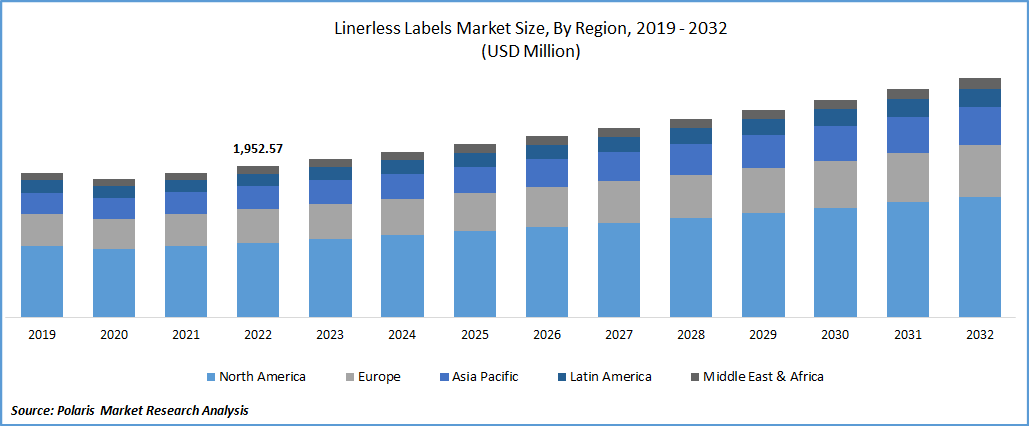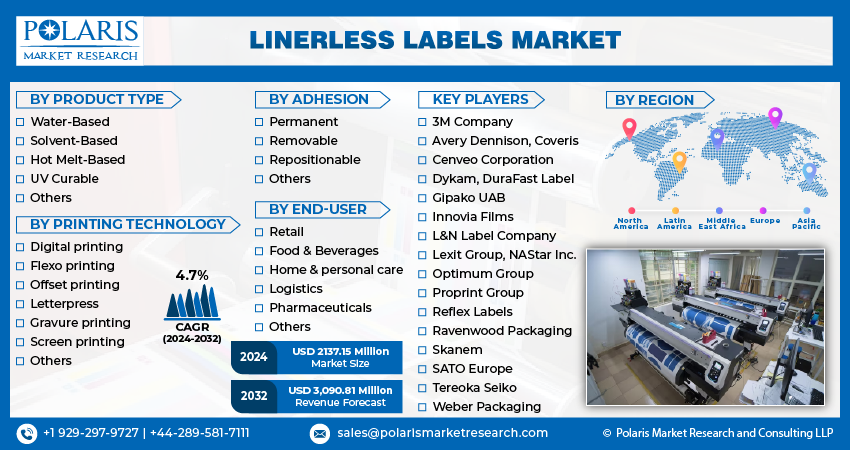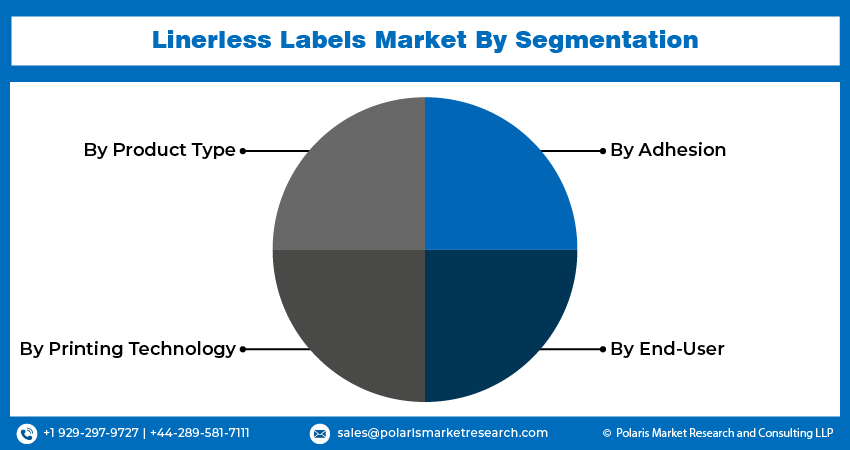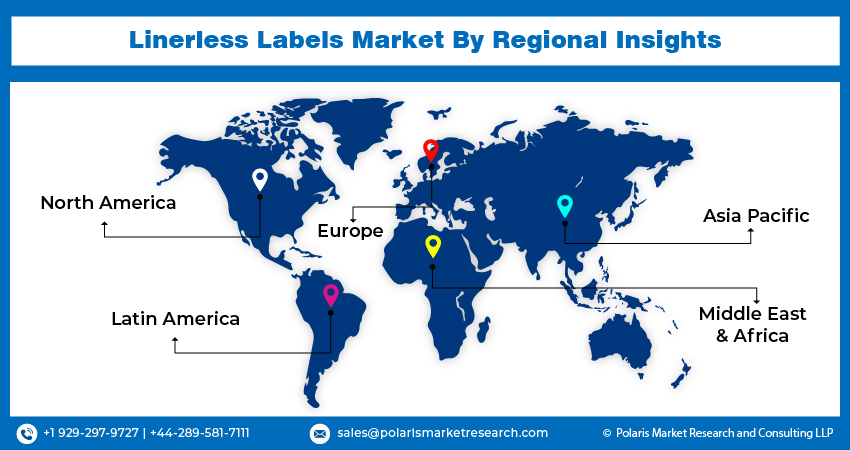
Linerless Labels Market Share, Size, Trends, Industry Analysis Report, By Product Type (Water-Based, Solvent-Based, Hot Melt-Based, UV Curable and Others); By Printing Technology; By Adhesion; By End Use; By Region; Segment Forecast, 2023-2032
- Published Date:Jan-2024
- Pages: 118
- Format: PDF
- Report ID: PM3314
- Base Year: 2023
- Historical Data: 2019-2022
Report Outlook
The global linerless labels market was valued at USD 2042.58 million in 2023 and is expected to grow at a CAGR of 4.7% during the forecast period. An important factor in establishing a brand's reputation is labeling. According to brand owners, labels now need to run continuing marketing campaigns, develop seasonal and regional variations, and respond to market changes more swiftly. The liner is specifically designed to be removed from labels without liners, also known as liner-free labels or labels without a back, and replaced with a release coating applied to the brand after the printing of the contents. According to a study by Ravenwood Packaging, the weight of the label roll will drop by 40%, with significant margins accounted for by lower liner costs and less need for storage space. Rejecting release liners also lessens the possibility of industrial accidents caused by their smooth-coated surfaces, which encourages using such labels in the logistics and food & beverage industries.

To Understand More About this Research: Request a Free Sample Report
Customers' lack of desire to spend valuable time preparing food, coupled with their busy lifestyles, long commutes, and long workdays, has led to a greater reliance on ready-to-eat foods & an increase in snacking, which has increased the need for linerless labels. In addition, strict government regulations in developing nations as a result of rising consumer awareness of food safety, increasing demand for sustainable brands, and growing preference for linerless labels in food and beverage packaged foods as a result of the increasing demand for eco-friendly, bio-degradable, & adaptable labels all significantly contribute to the market's expansion.
In developed economies, e-commerce is well established, while it is exploding in emerging economic giants like China and India. Such a high volume of items requires a tracking system to ensure that the right person receives the product. The shipments are labeled labels printed with codes and descriptions of the consignor and consignee to trace the consequences. By 2025, e-commerce enterprises are expected to transfer around 200 billion shipments annually, increasing the demand for labels. Traditional labels, however, generate much trash in the form of the release liner, which adds to the expense to the logistics service provider. As a result, e-commerce businesses increasingly use backing labels when printing labels for packages, opening up new market opportunities.
The emergence of COVID-19 has halted all activity worldwide. Customers are aware that the health crisis has enormously impacted firms across all industries. Increased public and corporate support can help in the fight against this highly contagious illness. While some sectors are doing well, others are having trouble. Almost every industry is anticipated to be negatively impacted by the epidemic.

Industry Dynamics
Growth Drivers
The main factor is the rising adoption of linerless labels across the verticals such as food and beverages industries and personal care, among others driving the linerless labels market growth over the forecast period. The requirement for linerless labels in food and beverage packaging and the growing need for environmentally friendly, biodegradable, and adaptable tags all contribute to the market's expansion. Food items are frequently purchased off the shelves due to brand familiarity. As branding relies heavily on labeling, this business has seen a significant rise in appealing but food-safe labels. In Asian and Latin American nations, ham, bacon, and fruits are packaged with rolled, liner-free labels.
Furthermore, the demand for larger labels has increased dramatically due to strict laws surrounding the information that must be written on the packaging of food goods. However, because they can have 30% more print than conventional labels, these labels can effectively replace traditional labels without changing their size, making them more affordable for food and beverage business customers. As per the United Nations, the food and beverage business is growing to satisfy the hunger of the approximately 7.3 billion people on the planet. This expansion will also translate into an increase in the market for linerless labels throughout the projection period.
Report Segmentation
The market is primarily segmented based on product type, printing technology, adhesion, end-user, and region.
|
By Product Type |
By Printing Technology |
By Adhesion |
By End-User |
By Region |
|
|
|
|
|
For Specific Research Requirements: Request for Customized Report
The repositionable segment is expected to witness the fastest growth during forecast period
Labels are typically removed once a product has been consumed because they are only intended for packaging and branding. However, in response to growing global worries about waste and pollution, businesses are looking for reusable labels that can be reclaimed from the market and applied to new items. Repositionable labels are frequently used as temporary labels, which may be placed briefly and then removed when the information is no longer necessary or outdated; unlike removable quick labels, repositionable labels can be preserved and reused.
They are also employed for applications that need a high degree of positional accuracy; the label can be applied, removed, and reapply if it is a little wonky or wrinkled until the desired location is obtained. When a brand needs to be moved and reused, static cling labels can also be used instead of the microsphere adhesive most repositionable labels employ. This repositionable segment is therefore anticipated to experience considerable growth throughout the projected period.
The flexo printing offset segment industry accounted for the largest share in 2022
Creating a flexographic print involves creating a 3D relief out of rubber or polymer using a positive mirrored master that contains the required picture. The printing process known as flexographic uses a flexible printing plate. These printing plates used to be constructed of rubber in the past, but today's modern enterprises employ adjustable photopolymer printing plates. On a web press, cylinders are encircled by vessels. Each color requires a different printing plate. Flexo printing is distinctive since it adapts to many materials and can employ a broad range of inks. It is possible to print this style of printing on virtually any substrate, including paper, plastics, and metal, because of its durability and adaptability.
Logistics segment industry accounted for the largest market share in 2022
The logistics and retail sectors typically use direct thermal printing technology because of its low-cost printing capabilities. As small as smartphones, direct thermal printers are portable and simple to produce labels as needed. Additionally, it costs less owing to using one ink color, increasing the possible profit margin for the logistics service provider.
Additionally, several linerless labels are used for fresh food, meat, fish, shellfish, fresh fruit, poultry, and ready-to-eat meals. Due to growing consumer demand for packaged and branded goods and improved customer awareness of product authenticity, the food industry's market is anticipated to expand more quickly. Since they help identify quality, source, and pricing, linerless labels are highly sought after in the fruit and vegetable industry.
Further, manufacturers of pharmaceuticals and personal care items are expected to use such cutting-edge printing technology to generate vibrant and eye-catching labels during the projection period, leading to a significant increase in the market share of laser printing. The affordability of the labels due to large-scale printing employing cutting-edge methods, including laser printing technology, draws producers from the food and beverage and personal care product industries.

The demand in Asia-Pacific is expected to witness significant growth during the forecast period
Asia Pacific is anticipated to hold significant growth due to the region's rapid e-commerce expansion and increasing use of these labels in end-user industries like retail and food and beverage in countries like Japan, India, and China. Additionally, it is projected that the region's excessive consumption of packaged and processed foods due to its rapid industrialization and urbanization will support regional market expansion.
The linerless label industry in Europe is also fragmented, with many small companies able to adapt quickly to shifts in consumer demand. Additionally, political and environmental regulations, as well as increasing raw material costs, significantly impact the popularity of linerless labels. The implementation of liner-free labels by the region's beverage makers will determine the market in Latin America. The Middle East and Africa market will develop in tandem with the region's logistics business, which is expanding due to the region's sizable shipping sector.

Competitive Insight
Some of the major players operating in the global linerless labels market include 3M Company, Avery Dennison, Coveris, Cenveo Corporation, Dykam, DuraFast Label, Gipako UAB, Innovia Films, L&N Label Company, Lexit Group, NAStar Inc., Optimum Group, Proprint Group, Reflex Labels, Ravenwood Packaging, Skanem, SATO Europe, Tereoka Seiko, and Weber Packaging.
Recent Developments
- In September 2022, Avery Dennison introduced a direct thermal liner-less label solution requiring an additional label in applications such as e-commerce, food delivery & pickups, QSRs, weigh scales, & few agency services.
- In May 2022, AM Labels added a new line of linerless label printers to its portfolio, decreasing the waste produced during printing. The labeling expert provides barcoding, RFID, manufacturing, and warehouse automation technologies.
Linerless Labels Market Report Scope
|
Report Attributes |
Details |
|
Market size value in 2024 |
USD 2137.15 million |
|
Revenue forecast in 2032 |
USD 3,090.81 million |
|
CAGR |
4.7% from 2024– 2032 |
|
Base year |
2023 |
|
Historical data |
2019- 2022 |
|
Forecast period |
2024 - 2032 |
|
Quantitative units |
Revenue in USD million and CAGR from 2024 to 2032 |
|
Segments Covered |
By Product Type, By Printing Technology, By Adhesion, By End-User, By Region |
|
Regional scope |
North America, Europe, Asia Pacific, Latin America; Middle East & Africa |
|
Key Companies |
3M Company, Avery Dennison Corporation, Coveris SA, Cenveo Corporation, Dykam A.C.A. Ltd., DuraFast Label Company, Gipako UAB, Innovia Films Inc., L&N Label Company, Lexit Group AS, NAStar Inc., Optimum Group, Proprint Group, Reflex Labels Ltd., RR Donnelley & Sons Company, Ravenwood Packaging, Skanem AS, SATO Europe GmbH, Tereoka Seiko Co. Ltd., and Weber Packaging Solutions Limited |
FAQ's
The global linerless labels market size is expected to reach USD 3,090.81 million by 2032.
Key players in the linerless labels market are 3M Company, Avery Dennison, Coveris, Cenveo Corporation, Dykam, DuraFast Label, Gipako UAB, Innovia Films, L&N Label Company.
Asia-Pacific contribute notably towards the global linerless labels market.
The global linerless labels market expected to grow at a CAGR of 4.7% during the forecast period.
The linerless labels market report covering key segments are product type, printing technology, adhesion, end-user, and region.
